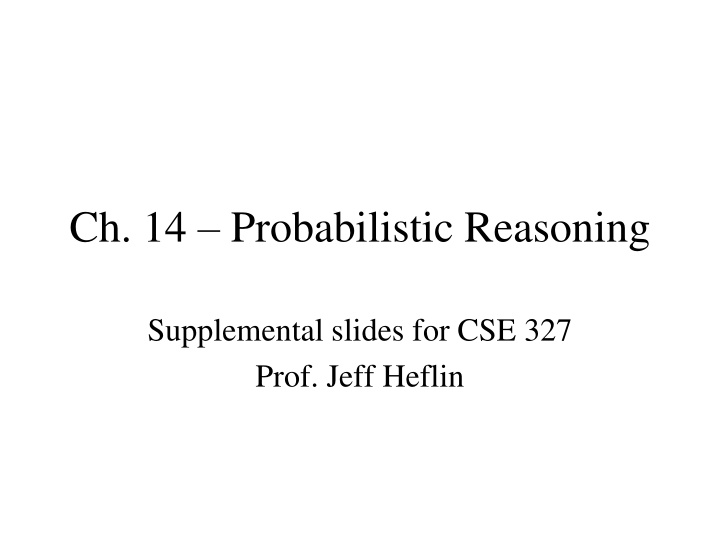
Probabilistic Reasoning in Bayesian Networks: Insights & Calculations
Learn about conditional independence, Bayesian networks, global and local semantics, tree of inference calculations, and how to calculate probabilities in a Bayesian network example. Understand the fundamentals and intricacies of probabilistic reasoning. Dive into the world of Bayesian networks and explore its practical implications.
Download Presentation

Please find below an Image/Link to download the presentation.
The content on the website is provided AS IS for your information and personal use only. It may not be sold, licensed, or shared on other websites without obtaining consent from the author. If you encounter any issues during the download, it is possible that the publisher has removed the file from their server.
You are allowed to download the files provided on this website for personal or commercial use, subject to the condition that they are used lawfully. All files are the property of their respective owners.
The content on the website is provided AS IS for your information and personal use only. It may not be sold, licensed, or shared on other websites without obtaining consent from the author.
E N D
Presentation Transcript
Ch. 14 Probabilistic Reasoning Supplemental slides for CSE 327 Prof. Jeff Heflin
Conditional Independence if effects E1,E2, ,Enare conditionally independent given cause C E E E C 2 1 ,..., , , ( n = i = ) C ( ) ( | ) E C n i 1 can be used to factor joint distributions P(Weather,Cavity,Toothache,Catch) = P(Weather)P(Cavity,Toothache,Catch) = P(Weather)P(Cavity)P(Toothache|Cavity)P(Catch|Cavity)
Bayes Net Example P(B) Burglary P(E) Earthquake 0.001 0.002 B E P(A|B,E) T T 0.95 Alarm T F 0.94 F T 0.29 F F 0.001 A P(M|A) A P(J|A) MaryCalls T 0.70 JohnCalls T 0.90 F 0.01 F 0.05 From Fig. 14.2, p. 512
Global Semantics atomic event using a Bayesian Network = i 1 P(b, e,a, j, m) = P(b)P( e)P(a|b, e)P(j|a)P( m|a) n = ( , ,..., ) ( | ( )) P x x x P x parvals X 1 2 n i i atomic event using the chain rule = n x x x P 2 1 ) ,..., , ( n = i ( | ,..., ) P x x x 1 1 i i 1 P(b, e,a, j, m) = P(b)P( e|b)P(a|b, e)P(j| b, e,a)P( m| b, e,a,j)
Local Semantics Each node is conditionally independent of its non-descendants, given its parents. U1 U2 Z1 X Z2 Y1 Y2 P(X|U1,U2,Z1,Z2) = P(X| U1,U2)
Bayes Net Inference y = P e P e y ( | ) ( , , ) X X Formula: Example: e a = ) ( | ( ) , ) | ) | ( | , ) ( ) ( ( P b j m P b P e P a b e P j a P m a P(b|j, m)= P(b)[P(e)[P(a|b,e)P(j|a)P( m|a) + P( a|b,e)P(j| a)P( m| a)] + P( e)[P(a|b, e)P(j|a)P( m|a) + P( a|b, e)P(j| a)P( m| a)]
Tree of Inference Calculations P(b)=.001 + P( e)=.998 P(e)=.002 + + P( a|b,e)=.05 P(a|b, e)=.94 P( a|b, e)=.06 P(a|b,e)=.95 P(j| a)=.05 P(j| a)=.05 P(j|a)=.90 P(j|a)=.90 P( m| a)=.99 P( m|a)=.30 P( m|a)=.30 P( m| a)=.99
Calculating P(b|j,m)and P(b|j,m) P(b|j, m)= P(b)[P(e)[P(a|b,e)P(j|a)P( m|a) + P( a|b,e)P(j| a)P( m| a)] + P( e)[P(a|b, e)P(j|a)P( m|a) + P( a|b, e)P(j| a)P( m| a)]] = (0.001)[(0.002)[(0.95)(0.9)(0.3) + (0.05)(0.05)(0.99)] + (0.998)[(0.94)(0.9)(0.3) + (0.06)(0.05)(0.99)]] = (0.001)[(0.002)[0.2565 + 0.002475] + (0.998)[0.2538 + 0.00297]] = (0.001)[(0.002)(0.258975) + (0.998)(0.25677)] = (0.001)[0.00051795 + 0.25625646] = (0.001)(0.25677441) = (0.00025677441) P( b|j, m)= P( b)[P(e)[P(a| b,e)P(j|a)P( m|a) + P( a| b,e)P(j| a)P( m| a)] + P( e)[P(a| b, e)P(j|a)P( m|a) + P( a| b, e)P(j| a)P( m| a)]] = (0.999)[(0.002)[(0.29)(0.9)(0.3) + (0.71)(0.05)(0.99)] + (0.998)[(0.001)(0.9)(0.3) + (0.999)(0.05)(0.99)]] = (0.999)[(0.002)[0.0783 + 0.035145] + (0.998)[0.00027 + 0.0494505]] = (0.999)[(0.002)(0.113445) + (0.998)(0.497205)] = (0.999)[0.00022689 + 0.049621059] = (0.999)(0.049847949) = (0.049798101051)
Normalizing the Answer P(b|j, m) = (0.00025677441) P( b|j, m) = (0.04979801051) = 1 / (0.00025677441 + 0.04979801051) = 1 / 0.050054875461 19.97807 P(b|j, m) (19.97807)(0.00025677441) 0.0051 P( b|j, m) (19.97807) (0.04979801051) 0.9949 P(B|j, m) = <0.0051, 0.9949>
